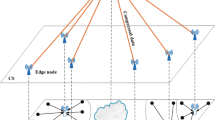Abstract
This paper proposes a method to save power consumption for Wireless Sensor Network (WSN) based environment monitoring system by using compressed sensing technique. Reconstruction process of compressed sensing data is complicated but compressed process is itself simple. On the other hand, although sensor nodes can use limited resources, the server has affluent resources. Therefore, sensor nodes compress time series measured environment data and the server reconstruct the compressed data. At the environment data collection stage, a sensor node uses compressed sensing for transmitting measured environment data. The server reconstructs the received environment data. This study develops the ZigBee WSN based time series indoor environment data collection system. Then this study investigates the impact on compressed sensing technique for WSN. Experiment results show that when setting compression ratio = 40%, the power consumption was reduced by 40% with satisfying the coefficient of determination > 0.8, which showed the effectiveness of the proposed method.
Access this chapter
Tax calculation will be finalised at checkout
Purchases are for personal use only
Similar content being viewed by others
References
Tseng SM (2003) A high-throughput multicarrier DS CDMA/ALOHA network. IEICE Trans Commun E86-B(4):1265–1273
Komuro N, Habuchi H, Kamada M (2004) CSK/SSMA ALOHA system with nonorthogonal sequences. IEICE Trans Fundam E87-A(10):2564–2570
Komuro N, Habuchi H (2005) A reasonable throughput analysis of the CSK/SSMA unslotted ALOHA system with nonorthogonal sequences. E88-A(6):1462–1468
Sekiya H, Tsuchiya Y, Komuro N, Sakata S (2011) Analytical expression of maximum throughput for long-frame communications in one-way string wireless multihop networks. Wireless Pers Commun 60(1):29041
Komuro N, Habuchi H, Tsuboi T (2008) Nonorthogonal CSK/CDMA with received-power adptive access control scheme. IEICE Trans Fundam E91-A(10):2779–2786
Kobayashi K, Nakamura A, Ohno K, Itami M (2016) Improving performance of DS/SS-IVC scheme based on location oriented PN code allocation. IEICE Trans Fundam E99-A(1):225–234
Heinzelman WR, Chandrakasan A, Balakrishnan H (2000) Energy-efficient communication protocol for wireless microsensor networks. In: Proceedings of annual Hawaii international conference on system sciences, pp 223–232
Lindsey S, Raghavendra C, Sivalingam KM (2002) Data gathering algorithms in sensor networks using energy metrics. IEEE Trans Parallel Distrib Syst 13(9):924–935
Fan X, Song Y (2007) Improvement on LEACH protocol of wireless sensor network. In: Proceedings of international conference on sensor technologies and applications (SENSORCOMM), pp 260–264
Luo CY, Komuro N, Takahashi K, Kasai H, Ueda H, Tsuboi T (2008) Enhancing QoS provision by priority scheduling with interference drop scheme in multi-hop ad hoc network. In: IEEE global communication conference (GLOBECOM), pp 1321–1325
Tuan DT, Sakata S, Komuro N (2012) Priority and admission control for assuring quality of I2V emergency services in VANETs integrated with wireless LAN mesh networks. In: International conference on communications and electronics (ICCE), pp 91–96
Sony CT, Sangeetha CP, Suriyakala CD (2015) Multi-hop LEACH protocol with modified cluster head selection and TDMA schedule for wireless sensor networks. In: Proceedings of global conference on communication technologies (GCCT), pp 539–543
IEEE Standards Association (2011) IEEE standard for local and metropolitan area networks Part 15.4: low-rate wireless personal area networks (LR-WPANs). https://ecee.colorado.edu/~liue/teaching/comm-standards/2015S-zigbee/802.15.4-2011.pdf
Lee B-H, Wu H-K (2010) Study on a dynamic superframe adjustment algorithm for IEEE802.15.4 LR-WPAN. In: Proceedings of IEEE VTC. Spring
Sun Y, Gurewitz O, Johnson DB (2008) RI-MAC: a receiver-initiated asynchronous dutycycle MAC protocol for dynamic traffic loads in wireless sensor networks. In: Proceedings of 6th ACM conference on embedded network sensor systems, pp 1–14
Kai N, Sakata S, Komuro N (2013) Dynamic active period control achieving low energy consumption and low latency in multi-hop wireless sensor networks. In: IEEE eleventh international symposium on autonomous decentralized systems
Akbar MS, Yu H, Cang S (2017) TMP: tele-medicine protocol for slotted 802.15.4 with duty-cycle optimization in wireless body area sensor networks. IEEE Sens J 17(6):1925–1936
Adcock B, Hansen AC (2016) generalized sampling and infinite-dimensionalcompressed sensing. Found Comput Math 16:1263–1323
Feng L, Axel L, Chandarana H, Block KT, Sodickson DK, Otazo R (2016) XD-GRASP: golden-angle radial MRI with reconstruction of extra motion-state dimensions using compressed sensing. Magn Reson Med 75:755–788
Beygi S, Jalali S, Maleki A, Mitra U (2019) An efficient algorithm for compression-based compressed sensing. Inf Inference J IMA 8(2):343–375
Author information
Authors and Affiliations
Corresponding author
Editor information
Editors and Affiliations
Rights and permissions
Copyright information
© 2021 The Author(s), under exclusive license to Springer Nature Singapore Pte Ltd.
About this paper
Cite this paper
Komuro, N., Suzumaru, R. (2021). Impact on Compressed Sensing for IoT Used Indoor Environment Monitoring System. In: Kim, H., Kim, K.J. (eds) IT Convergence and Security. Lecture Notes in Electrical Engineering, vol 712. Springer, Singapore. https://doi.org/10.1007/978-981-15-9354-3_9
Download citation
DOI: https://doi.org/10.1007/978-981-15-9354-3_9
Published:
Publisher Name: Springer, Singapore
Print ISBN: 978-981-15-9353-6
Online ISBN: 978-981-15-9354-3
eBook Packages: Intelligent Technologies and RoboticsIntelligent Technologies and Robotics (R0)




